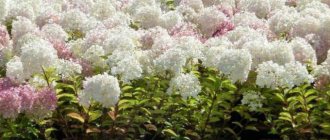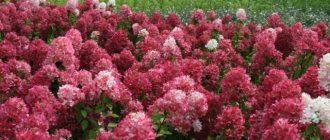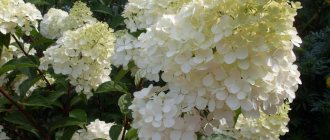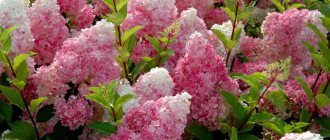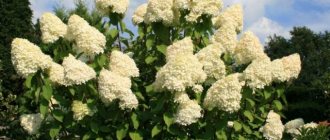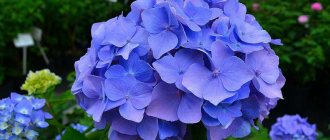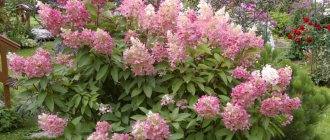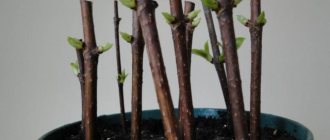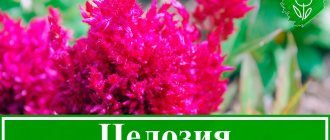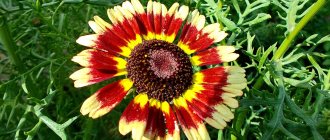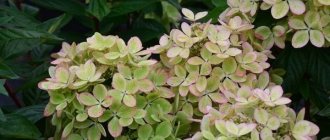History of selection
The hydrangea flower was first brought to Europe from China in the 18th century, and after 2 centuries the widespread popularization of this plant began. Soon, the variety of varieties and hybrid forms of hydrangea exceeded 100 varieties and subspecies, differing in height, bud size and degree of resistance to adverse weather conditions.
The Weems Red hydrangea variety was developed not so long ago. Its originator is the German breeder Wim Rutten. The main difference between the flower and others is the very early flowering time - the Weems Red hydrangea blooms earlier than all other types and varieties of hydrangeas.
Description of the variety
Hydrangea paniculata Weems Red is loved by gardeners for its abundant flowering and pleasant sweet aroma. The height of the shrub reaches no more than one and a half meters, but its inflorescences are up to 40 cm long, which, in combination with many small flowers, creates a unique decorative effect (see photo).
It is interesting that at the beginning of flowering the inflorescences are pure white, then they turn pink, and closer to autumn they acquire a rich wine color. With proper care, this variety of hydrangea pleases gardeners with its flowering for a very long time: from June until the first frost.
Description of paniculata hydrangea Weems Red
Hydrangea paniculata Wim's Red is a dense, fairly compact deciduous shrub, characterized by long and abundant flowering, which lasts from July to September, and even until October in regions with warm climates.
The average height of adult plants is 1.5-2 m. The shoots of Weems Red hydrangea are moderately rigid and weakly branched. The skin on the shoots is brown-red. Under the weight of large inflorescences, some branches of the hydrangea can bend, due to which the appearance of the bush begins to resemble a ball.
The leaves of Hydrangea paniculata are dense, ovate, dark green with pronounced veins. On the shoots they are located opposite. The inflorescences externally resemble tall, elongated pyramids. The length of the inflorescences varies from 20 to 35 cm.
As they bloom, hydrangea buds change color: at first they are white, but soon acquire a pinkish tint. Then this color smoothly flows into a rich burgundy tone.
The aroma of the Weems Red variety is pleasant, of medium intensity. Many gardeners note in their reviews that it contains pronounced honey notes.
A flowering bush of Hydrangea paniculata variety Weems Red is shown in the photo below.
Appearance, size and height of Weems Red hydrangea
Weems Red is a compact deciduous shrub, the height of which rarely exceeds 2 m. The growth of the crop is uniform. The variety is characterized by weakly branching and moderately rigid shoots. The bark of the branches is colored brownish-red. The leaves are dense, ovoid, dark green. Veins are clearly visible on the rough surface of the leaf plate.
The beauty of Wim's Red hydrangea
Hydrangea paniculata "Weems Red" was obtained by a German breeder several years ago and literally immediately gained recognition throughout the world. This deciduous shrub blooms profusely and for a very long time. The pyramidal inflorescences are large, up to 35 cm high. As flowering progresses, the color of the “Weems Red” buds changes: at the initial stage of dissolution, the paniculate buds are white, then it becomes pink and as a result the buds acquire a rich burgundy color.
Below you can see in the photo of the paniculate hydrangea “Weems Red” the color variety of inflorescences. Already faded buds also have natural beauty. Florists use them to create their works.
The long flowering period of paniculate hydrangea occurs from July to September. In warm autumn conditions, “Weems Red” can delight with its buds until October. This fact is an important advantage due to which the variety is widely popular.
Important! Throughout the flowering period, the "Weems Red" paniculate bush exudes a pleasant and alluring honey aroma.
As a result of flowering, a capsule is formed on the shoots of the Wims Red paniculata shrub. It is divided into several parts and contains many small seeds that can be used for propagation.
From the photo and description of the “Weems Red” hydrangea it is easy to understand that its bushes are very lush, beautiful, and leafy. The height and diameter of adult plants can reach 2 m. The annual growth of green shoots is 20-25 cm. Young bushes are not pruned for 3-4 years after planting. After the first age pruning, it is recommended to prune the bush annually.
The beauty and charm of hydrangea is provided not only by flowers, but also by leaves. They are very dense, oppositely located. They are distinguished by their dark green color and strong veins. The shape of hydrangea leaves is ovoid.
The shoots of the paniculate plant are hard and elastic, and may have sparse branches. The color of the skin on the shoots is brown-red, which gives them a decorative appearance. Under the weight of large buds, some shoots bend, as a result of which the bush takes on a spherical shape.
Source
When and how does Wim's Red hydrangea bloom?
The flowering period lasts from July to September. In warm weather it can bloom until early October. The inflorescences have a wide pyramidal shape. The average length is 35 cm. Weems Red has three stages of flower color: white gives way to pink, and pink to burgundy-red.
Interesting! The color of the inflorescences changes as the bush blooms.
Winter hardiness of hydrangea Weems Red
Weems Red does not tolerate drought well. The vital energy of a plant and its decorative properties are determined by the level of moisture in the soil and air. For this reason, we strongly do not recommend allowing the substrate to dry out.
Winter hardiness, as noted in the description of the variety, is -30 °C. Gardeners familiar with this variety of hydrangea claim that the frost resistance indicators are too high.
Resistance to diseases and pests
The plant's resistance to diseases is average. The greatest threat to Weems Red hydrangea is from the following diseases:
- chlorosis;
- powdery mildew;
- anthracnose
Plants can also be affected by the following pests:
- spider mite;
- aphid;
- Colorado beetle.
Optimal growing conditions for Weems Red hydrangea
To successfully grow Hydrangea paniculata "Weems Red" it is important to provide it with:
- Optimal soil composition;
- Necessary lighting;
- Humidity.
Peculiarities
Paniculata hydrangea "Weems Red" differs from other representatives of this family in that the variety has a very low growth. The plant cannot be higher than 1.5 m. The shoots spread out wide to the sides, which creates a stunning external effect. In this case, the inflorescences reach 0.3-0.4 m in length. The inflorescences are characterized by the shape of a narrowed pyramid.
The description of the Wim's Red variety notes not only the small height, but also the limited fertility of flowers (50%). The sterile half of the flowers usually have 4 lobes. The diameter of the flower is from 0.05 to 0.07 m. This indicator is the same along the entire length of the brush. Therefore, the inflorescences look delicate.
The earliest flowers are snow-white, gradually turning pink. And with the onset of autumn, the hydrangea becomes covered with a wine-red mass. The main thing is not even the attractive red color, but the exceptionally strong aroma, like honey. "Weems Red" is distinguished by large dark green leaves with a slight reddish tint. They reach their maximum grace in the autumn months, as soon as the foliage becomes covered with areas of metallic sheen.
This shine subtly flows into various shades:
The shoots are characterized by a dark red color. Flowering frequency - once a year. It occurs on last year's shoots. The winter hardiness of "Wims Red" is decent - the survival of the plant is guaranteed even in frosts of up to 30 degrees. But still, young shoots need to be covered at the end of autumn and mulched; only from the third year of development this is not necessary.
Review of hydrangea in the video below.
Main characteristics of Weems Red hydrangea
| Crown diameter and height in the middle zone | Deciduous shrub. Height 1.5 - 2 m, width 1 - 1.5 m. |
| Bloom | Blooms earlier than other varieties of hydrangeas. The flowers are collected in conical inflorescences. During flowering, it gradually changes color. The flowers bloom creamy white in June, gradually turning pink over the summer and turning deep red in September. |
| Foliage | The leaves are large, dark green with a metallic tint. |
| The soil | Demanding about soil fertility and moisture, prefers slightly acidic or neutral substrates. |
| Light | Light, partial shade. |
| Moisture | Moisture-loving. During hot summers and the growing season, additional watering is necessary. |
| Frost resistance | Frost resistance and winter hardiness are high, withstands up to -30°C in the middle zone. It is recommended to mulch young plants for the winter. |
| Pests and diseases | Quite resistant to pests and diseases. |
| Landing | Does not tolerate alkaline soils, reacts poorly to dry and over-compacted soil. The color of the inflorescences may change with changes in soil acidity. |
| Care and protection | Tolerates pruning well. |
| Purpose | Used as tapeworms, in groups in gardens and parks, natural gardens. Smoke and gas resistant, can be used in urban landscaping. |
| Latin product name | Hydrangea paniculata Wim's Red |
| Note | Does not tolerate lime. |
| Crown structure | Ornamental shrub with strong vertical shoots. |
Source
Growing conditions
The key requirements for growing this variety of ornamental plants are:
- soil quality and its chemical composition;
- humidity level;
- lighting characteristics.
Priming
"Weems Red" develops optimally when the soil is slightly acidic. Areas with a neutral acid-base balance are acceptable. However, it is impossible to get brightly colored flowers on them. Alkaline soil will completely destroy paniculate hydrangea. Therefore, it is absolutely forbidden to plant it where lime was placed.
In this case, high fertile soil qualities and the presence of a significant amount of organic matter are desirable. Hydrangeas do not develop well on sand. Their growth can slow down quite significantly. Brown peat or sawdust is used to acidify the soil. It is forbidden to add not only lime, but also ash and chalk to the soil.
Temperature and humidity
Panicle hydrangeas need partial shade. Direct sunlight should only fall on them in the early morning or evening hours. During the day, the bushes are covered with taller plants or buildings. In principle, you can grow this shrub in full shade. However, with a lack of lighting, flowering becomes unreasonably scarce.
Hydrangea needs moisture in large quantities. Sometimes even special watering is not enough. Therefore, it is advisable to plant this variety in humid places. Of course, the land should not be swampy - this is also bad. If in summer there is not enough naturally flowing water, additional irrigation is necessary.
Application in landscape design
Decorating a garden flower bed, garden or yard path involves planting unpretentious shrubs or flowers. The Weems Red hydrangea is especially popular among amateur gardeners. A bright flower shrub cannot help but attract attention, because it differs from other types of flowerbed and garden plants in its riot of colorful inflorescences.
Hydrangea is a versatile plant. It easily fits into both simple design solutions for landscaping areas and the most diverse ones.
Landscape designers love this variety of hydrangea for its advantages, such as:
- resistance to pests and diseases;
- ease of care;
- unpretentiousness to weather conditions;
- long flowering period;
- variety of colors of inflorescences;
- pleasant honey aroma.
The picturesque hydrangea paniculata Weems Red is one of the few cultivated plants that can please with its splendor. This garden shrub, originally from Mauritius, has taken root in the natural and climatic conditions of Russia and attracted the attention of domestic breeders. Weems Red decorates gardens, lawns and flower beds with rich colors throughout the warm season.
It is worth noting that this shrub attracts attention not only with its large paniculate inflorescences, but also with its beautiful dark green foliage, which changes its color to silver-golden in the autumn. The hydrangea bush has a spherical shape, reaches a height of 1.5 meters, the length of the inflorescence brushes ranges from 30 to 40 cm.
Choosing a landing site
Since Wims Red loves both moisture and warmth, it should be planted in shaded areas with moderate sunlight. This will allow the plant to fully develop even with infrequent watering.
In sunny vacant lots and in the shade, the hydrangea root system does not grow to its full potential. As a result, the shrub is characterized by weak foliage and a lack of flowers. Even increased watering may not give the desired effect. If the conditions for planting hydrangea are met, it is accepted quickly.
Hydrangea is the queen of the garden. No other flowering plants are planted within the circumference of this deciduous shrub at a distance of one and a half meters. With its large inflorescences, hydrangea shades the area and prevents them from growing fully, whereas, given a favorable location, it can grow for up to 60 years.
Reproduction methods
Hydrangea paniculata varieties Weems Red are propagated in different ways. You can do this:
- seeds;
- layering;
- cuttings.
This flower is practically not propagated by seeds, since this method has many disadvantages. Hydrangea seeds have low germination, and growing full-fledged seedlings is time-consuming.
Cuttings for propagating hydrangeas are taken as annuals. Old shoots do not take root well. The algorithm for preparing cuttings is as follows:
- The bush is cut at the bottom, immediately after the bud. The total length of the cutting should be 15-18 cm and contain at least 3 internodes.
- Cut cuttings are immersed in water for 3 days.
- For better development of hydrangea, it is recommended to treat the lower cut of the cutting with any growth stimulant.
- After the specified time, the cuttings are planted in a container with a pre-prepared peat mixture. The cuts are deepened by 2/3 of the total length.
- After planting the cuttings, the soil is moistened daily.
- In spring, planting material is planted in open ground.
As a rule, preparation of cuttings begins in late June and is completed by autumn.
The procedure for propagation by layering includes the following steps:
- In spring or late summer, one of the lower shoots of the hydrangea is bent towards the ground and attached to the ground with a metal bracket.
- Then the place of contact with the soil is cut and slightly deepened. It is important that the end of the shoot is in a vertical position.
- Next year the cuttings should take root. Then it is carefully separated from the bush and moved to a new place.
With this method of propagation, hydrangea blooms the very next year after planting.
Growing from seeds
If the gardener gets the seeds, then you can try to plant them and grow your own hydrangea from seeds according to the description of the technology.
Seed sowing technology:
- The seeds are soaked in a saline solution to remove dead seeds. All that has surfaced will no longer live and such seeds are thrown away.
- The remaining ones are soaked in any growth stimulant for a couple of hours.
- At this time, prepare the tray. It should have drainage holes to drain excess water after watering.
- Fill the container with nutritious and loose soil.
- We moisten the soil with warm water and manganese. The solution should be pale pink.
- We spread the seeds over the surface of the soil and cover with a transparent bag.
- As soon as the seeds germinate, the cover is removed.
- At the stage of 2-3 true leaves, seedlings are planted 2-3 pieces into a separate container.
How does hydrangea propagate?
The correct choice of garden hydrangea variety for growing in the Urals does not guarantee that the flower will grow and delight its owners
It is important to properly care for shrubs. If you trim the bushes in a timely manner, water the soil, and feed the hydrangea, then you can get beautiful, abundant flowering in just 4 years. Bushes can be planted as seedlings or propagated in other ways.
Growing hydrangea at home is possible:
Bushes can be planted as seedlings or propagated in other ways. Growing hydrangea at home is possible:
- seeds;
- layering;
- seedlings.
On a note! Hydrangea blooms only 4-5 years after planting. Although today there are many varieties offered that produce flowers in the first year of life. You shouldn’t get too carried away with them, especially in the Urals, since such species are afraid of frost and may simply not survive the winter.
Cuttings
Propagation by cuttings begins in early spring. It is at this time that the sprouts are separated from the mother bush and planted in separate beds or pots. Before the onset of cold weather, the plants are placed in the basement. After winter, in the spring the pots are brought out into the warmth again. Green branches are removed from new shoots, and the resulting skeleton with roots is planted in a permanent place. The branches should be positioned to resemble a fan. Young hydrangea bushes must be mulched before winter so that the plant can survive the winter on its own.
By layering
Layers should begin to form in early spring. The soil around the plant is dug up and radical paths are made, up to 2 cm deep. One sprout is laid out in each path and pinched with pieces of cut wire. The top of the sprouts is covered with earth.
Note! By the end of summer, the shoots will take root, when new ones appear on the surface, it is worth allowing them to strengthen and take root, and then divide the bush and plant cuttings in a new place
Seeds
Growing from seeds is a more labor-intensive process. They are planted in separate pots in early March and covered with film or glass. Until germination, the temperature is maintained around +22. In this case, the ground should be moist, and there should always be light in the room. After 35-40 days, shoots will appear. They are left untouched for two weeks, and then taken out into the fresh air, constantly increasing the time they spend. When the growth of a small hydrangea reaches 10 cm, it can be planted in a permanent place.
Fertilizer for garden hydrangea
On a note! You can grow hydrangea using any of these methods, but the most reliable method is propagation by cuttings.
Planting paniculata hydrangea Weems Red
According to the description of the Weems Red hydrangea variety, planting and subsequent care of the flower will not be difficult. If the planting dates and site requirements for planting are met, there will be no problems with growing these flowers.
Recommended timing
Hydrangea of this variety can be planted both in autumn and spring. Each time has its advantages depending on the planting region.
In the Northern regions, when planted in spring, the chances of the plant to take root are somewhat higher than when planted in the fall. In temperate and warm climates, it is better to plant hydrangea in the fall, since after hardening by the winter cold, the plants develop more actively in the spring.
The soil for flowers is prepared in advance. 15-20 days before planting the seedlings, the area is dug up and fertilized with a mixture of peat, sand, leaves and turf soil.
Where to plant Weems Red hydrangea
Hydrangea paniculata develops best in conditions of high humidity, since its root system is not sufficiently developed and cannot independently take moisture from the lower layers of the soil. That is why it is better to give preference to shaded areas, although with frequent watering the flower grows well in the sun.
It is also important to provide flowers with protection from strong winds. It is better to plant bushes in areas provided with reliable barriers on the north side.
Despite the fact that hydrangea is considered an unpretentious plant, for the best development of the flower it is recommended to pay attention to the type of soil of the potential planting site. They usually focus on loose fertile soils with neutral or high acidity.
Important! Depending on the acidity level of the soil, the color of hydrangea buds varies greatly. Rich colors can be obtained by growing flowers in acidic soils.
This variety should absolutely not be planted on sandy soils or soils with a high lime content. However, if necessary, the acidity of the soil can be adjusted: to do this, the area is dug up and fertilized with fresh manure or sulfur sulfate. You can also use colloidal sulfur.
What kind of soil is needed
Although hydrangea is considered an unpretentious plant, it still makes certain demands on the soil. Fertile soil containing a lot of organic matter is suitable for it. Acidity level – neutral or increased.
However, it is worth remembering that the color of the inflorescences will depend on the acidity:
- In a neutral environment, the buds are pale;
- In acidic soil, the inflorescences will acquire a rich and bright color.
Experienced gardeners recommend acidity for Wim's Red with a pH level of 5.
Advice! Soils with a high content of sand and lime are absolutely not suitable for growing this bush. If this is the kind of soil in your garden, then you can acidify it to the required level.
To do this, add iron sulfate, sphagnum moss, fresh manure or colloidal sulfur to the soil.
Land with alkaline acidity is also not suitable. This can have a detrimental effect on the plant itself, as it may develop chlorosis. This will cause all the hydrangea leaves to fade.
Selection and preparation of planting material
When choosing seeds for planting directly into the ground, you should pay attention to the age of the planting material. Old seeds have poor germination.
When choosing seedlings, the recommendations are the same as for many other garden crops. There should be no stains or plaques on the surface of the plants, as well as mechanical damage, since small wounds can easily infect the crop with a fungus or other infection.
How to plant Weems Red hydrangea
Planting hydrangea varieties Weems Red is carried out according to the following plan:
- In the prepared area, planting holes are dug 40 cm deep. The diameter of the holes is at least 50 cm. The recommended distance between two adjacent holes is 90-100 cm.
- The fertile top layer of soil from the site is poured into the bottom of the planting hole. The layer thickness should be about 10-12 cm.
- In the center of the hole, a small hill resembling a hill is formed from this earth.
- The seedling is lowered onto this hill so that its roots are evenly distributed over the surface of the fertile soil. After deepening the plant, the root collar should remain above ground level.
- After the seedling is covered with soil, the soil is lightly compacted.
- Planting is completed with abundant watering.
Advice! For better moisture retention, you can mulch the flower’s trunk circle with straw or peat.
Additionally, the process of planting hydrangeas is described in the following video:
Planting and care
How to plant paniculate hydrangea correctly? First of all, you need to choose the right time to plant the shrub. This can be done either in late autumn or early spring. However, most experts say that a flower planted in autumn develops much more actively. Care and planting are almost the same depending on the season. It’s just that the seedling will get stronger over the summer and will have a better chance of surviving in unfavorable conditions.
For this variety of hydrangea, the composition of the soil in which the plant will develop is very important. The shrub prefers acidic or neutral soils
The soil should be well-drained, fertile, with sufficient moisture. It is worth noting that the color of the inflorescences is always brighter in acidic soil.
Before you start planting, you should prepare a hole measuring 50x50 cm in width and length, and 40 cm in depth. Planting usually takes about two days. On the first day, a hole of the required size is dug, after which 3 buckets of water are poured into it
For the proper development of the plant, it is very important that the soil is well saturated with moisture, so the hole is left in this condition until the morning
On the second day, care should be taken to fertilize the seedlings. The soil mixture usually consists of peat and fertile soil in equal quantities. It is necessary to mix sand and humus separately. Then these compositions are mixed in a 2:1 ratio, after which urea, potassium sulfate and superphosphate are added to the mixture
These organic fertilizers are very important for this plant.
With the prepared soil mixture, it is necessary to fill the hole almost to the top, leaving only 10-15 cm. Now it is time to plant seedlings, the roots of which must be carefully straightened, and then dug in with the earth that remains after creating the hole. Hydrangeas planted in the fall will require a little more effort. Care and planting of hydrangea in open ground is complemented by the fact that the seedling should be covered for the winter. This procedure is carried out without fail, despite the frost resistance of the plant.
When choosing a planting site, you should pay attention to partial shade. However, in some cases, such planting may result in the inflorescences losing their brightness.
This most often occurs due to the fact that the soil was not prepared enough. Most gardeners say that this variety of hydrangea thrives in a sunny area, provided that the plant is protected from the wind.
Caring for paniculata hydrangea Weems Red
Hydrangea Weems Red is quite resistant to most diseases and tolerates low temperatures well. If we add to this the undemanding nature of the light level, then caring for the flower comes down to only regular watering (since the plant is moisture-loving), optional fertilizing and pruning.
Seasonal care
In the summer, we must not forget about timely watering with warm water and applying fertilizers.
In the spring, pruning is done, cutting out all thin and broken branches. The rest are shortened by 2-3 buds. The thicker the branch, the more buds you can leave on it.
In the fall, watering is reduced and fertilizers are stopped so that the branches ripen and can withstand the winter period.
In winter, the bushes are in a dormant stage.
Watering
The frequency of watering depends on the prevailing weather. During frequent rains, plants are practically not watered. On hot days, the norm is up to 30 buckets of water per 1 m2. The top layer of soil near the bush should always be slightly moist.
Important! To water Hydrangea paniculata variety Weems Red, use only settled water.
Top dressing
The plantings are fed with potassium or ammonium sulfate, but only until mid-July. In August, superphosphate is already used.
The Weems Red variety also responds well to fertilizing with organic fertilizers. Whey, which acidifies the soil, has proven itself especially well. This fertilizing promotes abundant flowering and growth of green mass.
Mulching and loosening the soil
Immediately after planting, it is necessary to shallowly loosen the flower’s trunk circle and mulch it with sawdust. This is necessary in order to create a moderately humid microclimate near the root system of the plant.
Care during the flowering period
With the beginning of flowering, the bushes need systematic feeding with fertilizers for flowering plants. They contain a lot of potassium and phosphorus, which are necessary for beautiful lush flowering.
Landscape: use in decorating gardens, flower beds
This colorful shrub looks great both in a group and when growing a single plant. It is often used to create contrasting flower beds. It looks great surrounded by conifers and other evergreen shrubs.
With the help of Wims Red hydrangea you can decorate a hedge or alley to your house. This use of the plant will allow you to create a beautiful landscape accent and fill the air around with a subtle aroma with notes of honey.
Despite the care requirements, paniculate hydrangea is available for planting in private areas. If you follow the rules of care, it will reward you with long, lush and incredibly beautiful flowering.
Pests and diseases of Weems Red hydrangea
The most common disease of paniculate hydrangea is chlorosis. Most often occurs on alkaline soils. To return color to the leaves, iron chelate is used for foliar feeding. Use the drug once a week. To prevent this disease, you can bury iron objects - nails, horseshoes - into the hole near the plant.
When affected by white rot, the bush turns brown and signs of decay appear. The leaves are covered with a “web”. Phytosporin is used to treat this disease.
The appearance of yellow-green spots on the leaves indicates powdery mildew. Over time, the damaged areas become brown.
On a note! If such a sheet is turned over, the reverse side will have a metallic tint.
If there are no buds on the bush, and uneven, vague ring-shaped spots appear on the leaves, the plant is suffering from hydrangea ring spot. This disease has no cure. The plant is destroyed.
Does not bypass hydrangea and aphids. It can be detected by the curled apical leaves. If you unfold such a leaf, aphids will sit on the back side. Some gardeners recommend washing it off with soapy water and a sponge. But it will be much more effective to treat the plant with an insecticide.
Untreated plants may suffer from anthracnose, spider mites, and Colorado potato beetles. In order not to think about what exactly affected the plant, preventive treatment of the bushes is carried out with fungicides such as Skor, Maxim, Horus, Aktara.
Source
A little historical background
Large-leaved hydrangea was the first to appear in Europe. This happened at the very end of the 18th century. It was brought by French travelers from the island of Mauritius, located in the Indian Ocean. Prince of the Roman Empire K.G. was also a participant in this first round-the-world expedition for the French. Nassau-Siegen. It is believed that he named the beautiful plant in honor of his beloved sister.
Large-leaved hydrangea was born on the island of Mauritius and appeared in Europe thanks to the first French expedition around the world. It’s impossible not to notice such a beauty even in the luxurious governor’s garden
However, other sources claim that the shrub received its name in honor of the beloved of the French doctor F. Commerson. There is also a less romantic version of the appearance of this name: the bush was discovered in the governor’s garden. So they named it in honor of this event in Latin hortensis, which means “from the garden.”
Otherwise, this moisture-loving bush is called hydrantia. Translated from Greek, hydor means “water”, and angeion means “vessel”. Moreover, the point was not only that the bush needs frequent watering, but also that its seed pods look like a vessel - a jug. But the more pleasing name to the ear gradually prevailed over the Latin.
Source
Site selection and lighting
It is important to choose the right site for planting. Planted in the shade, hydrangea will feel good, but may lose a little brightness of color.
The ideal area would be where the plant will receive a lot of sunlight, but in the midday heat, hydrangeas still need shading. The plant especially needs sun in the first half of the day, so if possible, plant the bush on the eastern side of the site.
Reviews from flower growers about Weems Red hydrangea
Ivanova Veronika Aleksandrovna, 34 years old, Stavropol
I was looking for unpretentious flowers for my garden plot, I came across a description of the Weems Red hydrangea variety and decided to read the reviews. It was indicated on various sites that the flower is easy to care for, it tolerates cold without problems and blooms well. So far, everything is as it is: the flowering is really good, abundant, long-lasting, pests are not bothering us, and diseases have not yet affected us. In general, I'm very pleased. For a beginner gardener - just right.
Rybina Anna Grigorievna, 29 years old, Dolgoprudny
I have mixed impressions about these flowers. Yes, this variety of hydrangea looks beautiful and the aroma is very pleasant. Caring for it is simple and takes very little time. Problems with hydrangea arise only when we are preparing for winter. Personally, it’s difficult for me to bend the bushes to the ground, I’m afraid of breaking them. But it grows alone in my flowerbed. For some reason, other flowers next to her begin to fade over time. Perhaps this is because I sometimes acidify the soil. So, the composition did not work out. I planted a couple more hydrangea bushes nearby - only then did a beautiful flower bed emerge.
Veronika Klimova, 33 years old, Sevastopol
I recently got paniculate hydrangea "Weems Red". I bought it from a nursery, where I was guaranteed protection from diseases. So far there are no complaints: it blooms regularly, for a long time and very beautifully. Diseases and pests do not “take” it.
Anna Yakovleva, 25 years old, Dolgoprudny
I wanted to plant paniculate hydrangea “Weems Red” in a common flowerbed, but over time I realized that some of the plants around it were beginning to die. This is probably because I periodically acidify the soil. As a result, my hydrangea grows beautiful, but lonely.
Source
Blooms from early June to October
Wims Red description and photo:
- Blooms earlier. Hydrangea Wims Red (WIM'S RED) blooms earlier than others. Blooms from early June to October. Three-stage flowering. At the beginning, white flowers bloom, then there is a smooth transition to pink, and by the end of flowering the panicles become bright burgundy.
- Prefers acidified soil. The plant grows in slightly acidified soils. The root system spreads over the surface, so it needs frequent and abundant watering. The bush reaches a height of 1.2 m in height and 1.5 in diameter. Prefers bright places, protected from direct sunlight.
- Resistant to diseases. The variety is easy to care for and resists many viral and bacterial diseases. Has good decorative qualities. Bright burgundy-red branches are surrounded by pleasant lush green foliage. Goes well with conifers and deciduous plants.
The channel “Florists of all countries unite” talks about the varietal qualities of the Weems Red hydrangea.
